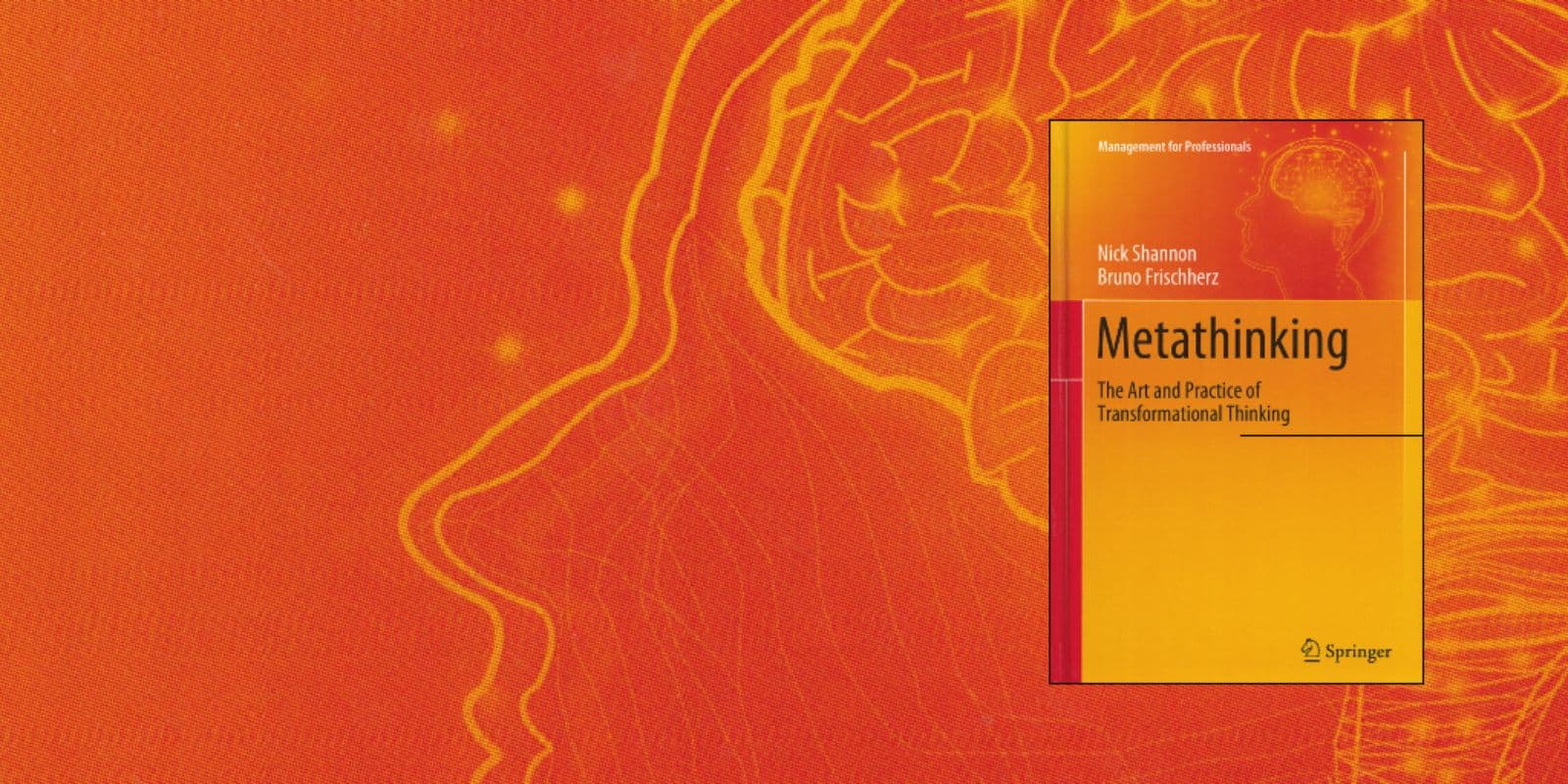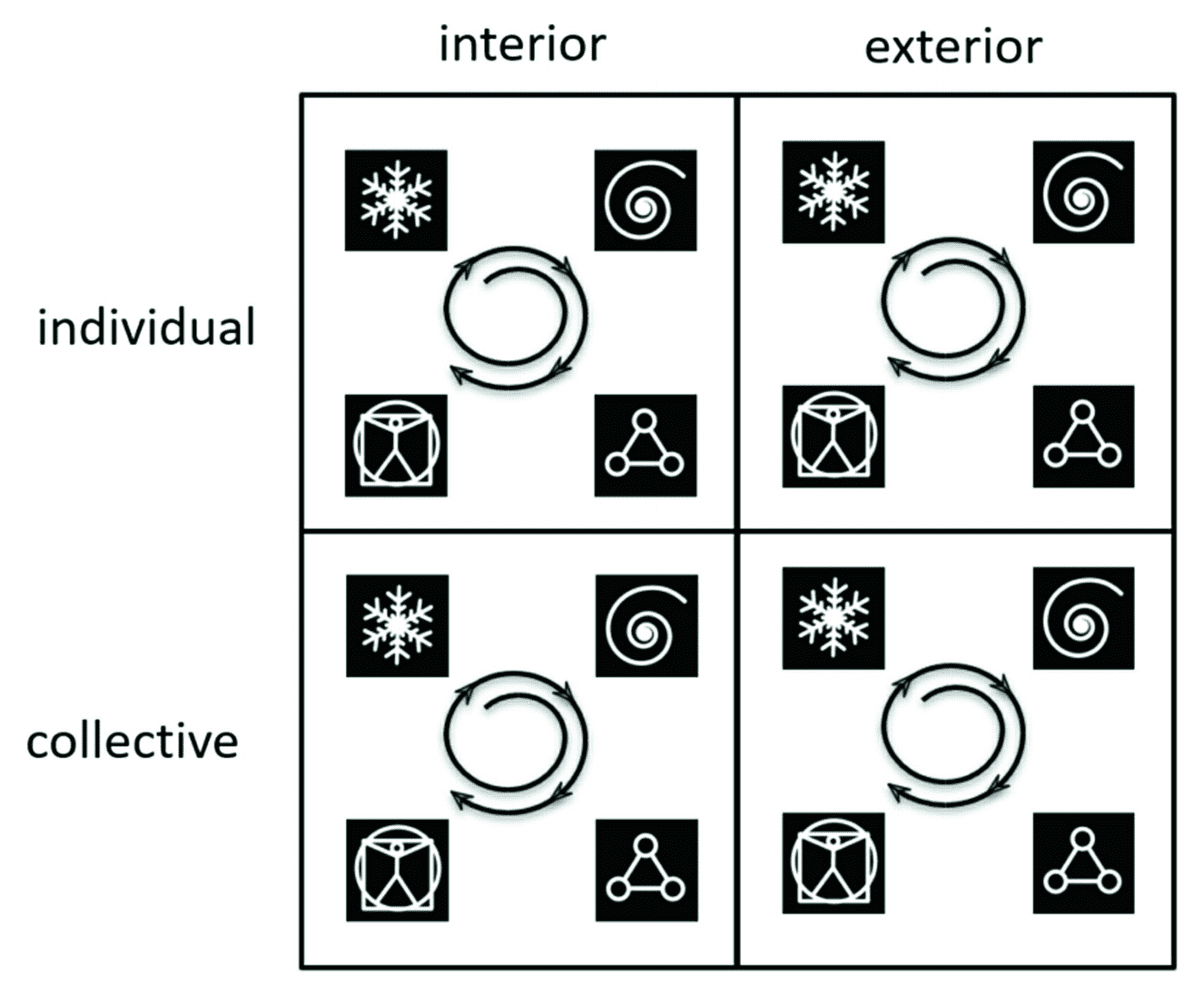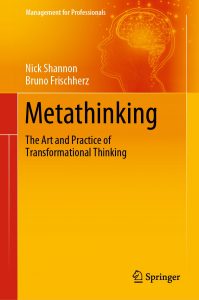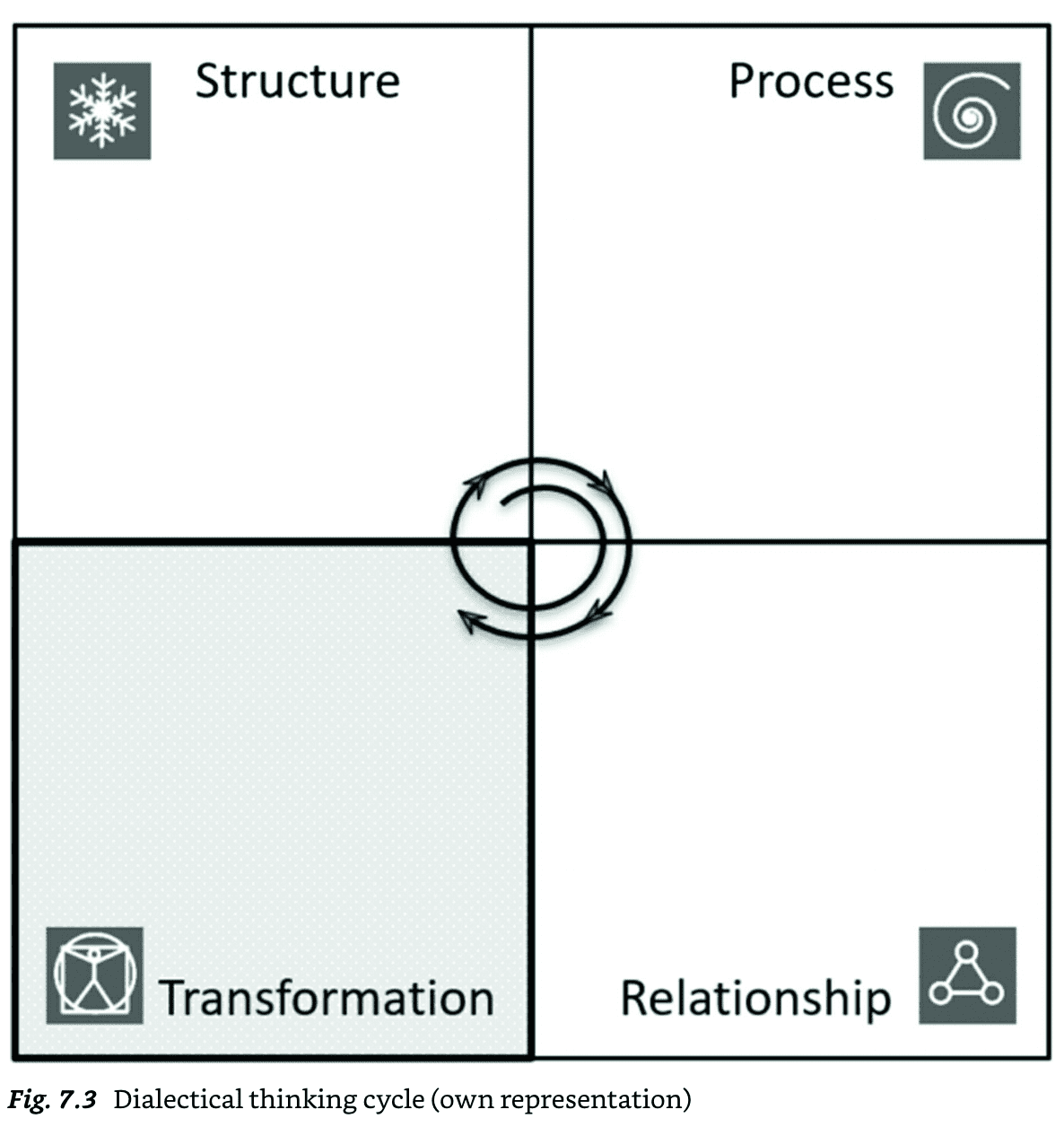This is a book summary of Metathinking: The Art and Practice of Transformational Thinking by Nick Shannon and Bruno Frischherz (Amazon):
For a video intro to Metathinking, check out:
Quick Housekeeping:
- All content in quotation marks is from the authors (content not in quotations is paraphrased).
- All content is organized into my own themes (not necessarily the authors’ chapters).
- Emphasis has been added in bold for readability/skimmability.
Book Summary Contents:

The Art of Transformational Thinking: Metathinking (Book Summary)
About the Book
“How can you become a better thinker? This is the question that this book seeks to answer.”
- “This book is an attempt to redress the balance by helping readers identify the patterns in their thinking and expand their thought processes by choosing alternatives. It is intended for the general reader with an interest in developing a broader toolkit of thinking skills with which to deal with the increasing complexity of today’s world.”
- “In this book, we want to advance the idea that, despite its flaws, the human mind has a very important trick up its sleeve, one that (Daniel) Kahneman underplays. That trick is the process of reflective thinking. We have the capacity to examine our own thoughts and from there to ‘rethink’ them.”
- “It is this process of reflecting on your own thought processes to which we draw your attention throughout this book, because by noticing your thinking you have the capacity to change your thinking. We call this process ‘Metathinking’. Using Kahneman’s terminology, it might also be called ‘System 3’ thinking. More specifically, this book is designed to help you recognise what is missing from your thinking currently and, from there, to become a stronger, deeper thinker.”
Logical & Dialectical Thinking
“Our aim as Metathinkers is to be able to shift from one type of thinking to another in order to set our thinking free to see reality in new ways. Accordingly, we will now look in more detail at the differences between two types of thinking—logical and dialectical thinking.”
Logical thinking:
monologic, static, constrained by rules, ‘if this, then that,’ follows specific systematic rules that determine whether a conclusion is justified given its premises, assumes a connection or a chain of causality.
Deductive reasoning:
- “Deductive thinking is the process of deriving a particular conclusion from a set of general premises or rules. Deductive conclusions are always true.”
Inductive reasoning:
- “Inductive thinking is the process of deriving a general conclusion or rule from a set of particular cases. Inductive conclusions are considered always true until otherwise discovered.”
Abductive reasoning:
- “Abductive thinking is the process of deriving a possible conclusion from a set of individual cases. Abductive conclusions are potentially but not necessarily true.”
Dialectical thinking:
dialogic, dynamic, looser, contains connections, follows certain patterns, focuses us on removing what constrains and limits us, points the way to seeing what is not there (and yet could be there), sheds light on different aspects of a particular concept and finds a way to overcome contradictions (‘illumination’ and ‘remediation’), seeks to explore and expand how a person sees and understands reality, takes concepts and explores what is missing or absent in terms of the context, dynamics, and relationships (and hence how that concept might be transformed).
Eastern & Western thinking:
- “The name we give to the type of thinking that is more typical of Eastern and particularly Chinese cultures and that is characterised by tolerance of ambiguity and contradiction is that of ‘dialectic’ which comes from the Greek, meaning ‘through speech’.”
- “In Chinese culture, the opposites of yin and yang describe contrary aspects of human experience that are also interconnected and interdependent. The interaction of yin and yang gives rise to a whole that is more than the sum of its parts and in so doing, yin and yang transform each other. Such thinking appears to be much less a part of Western society where thinking seeks to resolve and remove contradictions as opposed to accepting or even welcoming them.”
- “The analytic tradition of Western thought separates, isolates, and reduces complex concepts to their constituent parts and gives us clarity about cause and effect, priorities, and order. The more holistic approach of Eastern thought draws attention to the importance of contexts and the idea that there is a bigger picture, and gives rise to tolerance of differences and acceptance of contradictions and paradox.”
Socrates & Hegel:
- “The philosophical use of the term (‘dialectic’) often refers to the process of Socratic dialogue by which the Greek philosopher Socrates would show someone how their beliefs and ideas were contradictory.”
- “Hegel’s notion of dialectic is commonly described in terms of a three-step process involving considering first a ‘thesis’, then its opposite or contradiction, the ‘antithesis’, and then finally the creation of a new idea or ‘synthesis’ that encapsulates both the thesis and the antithesis.”
Dialectic & Dialogue:
- “We make sense of our world by constantly talking to ourselves in our heads. But the roots of thinking are found in social interaction with other people, which provides us with a model of the dialogue we then have in our minds. We replay conversations, think of things we wish we had said (but didn’t), think of what we will say and make plans as if we were talking to someone else.”
- “Dialectical thinking is thinking in dialogue with another person or even with yourself. One person may state a point of view, and the other will reply with a different, opposing point of view. As both parties listen to each other’s thinking, a third point of view may emerge that is, in some way a combination of both the earlier points of view. Dialogue enables people to identify and reveal absences in each other’s thought processes, leading to a richer and more nuanced appreciation of a topic, without which a person’s thinking may remain very partial. We see dialogue as a process of opening up the mind of another person.”
- “Dialogue happens between two or more people trying to establish a mutual understanding. In dialogue, two people encounter and then reconstruct what each other has in mind. They compare and integrate what each other holds to be ‘true’ about their experience of reality. There cannot be a dialogue with only one person, that would be a monologue. In dialogue, there is a tension between comprehension and incomprehension, and feedback mechanisms will indicate whether an interaction was successful or not. Misunderstanding, partial understanding and repairing sequences are normal phenomena of this process. If we introduce an observer into the dialogic situation, we have three perceptual positions from where the participants can perceive the dialogue: that of the self, the other and the observer. In this view, a dialogue is an opportunity to provide information from three different perspectives: from the first-person perspective as the person appears in the mind of herself; from the second-person perspective as the person appears in the mind of a dialog partner and from the third-person perspective as the person appears in the observer’s mind. The interrelation of these three different perspectives provides a richer picture of the social situation than a single view from only one of these positions.”
4 principles of dialectical thinking:
- Holism: Dialectically, nothing can be viewed in isolation. There is always a bigger whole to be considered and each thing that one looks at is just a part of that whole.
- Dynamism (or constant change): Everything that exists can be considered to be in a state of motion, never static but always, in a sense, becoming what it is not already and, at the same time, leaving some of what it is behind.
- Relationship (or common ground): Each and every thing is related in some way to everything else, and it is those relationships that give the thing its essence.
- Transformation: This principle is rather harder to grasp than the other three because in some ways it is a combination of them. It is the principle of significant change occurring via a movement through forms, to which all living systems are subject. Transformation is very often developmental in that there is movement towards a new form that transcends and includes the previous form, but it can also be regressive in the sense of a form breaking down, collapsing or reversing its previous growth.
What is Metathinking?
Metathinking is ‘meta’ because it both includes and transcends the thinking we do within a particular system of thought. Metathinkers shift from one type of thinking to another in order to set our thinking free to see reality in new ways.
Metathinking is…
- thinking about our thinking (thinking where we are actually thinking about the different systems of thought; moving to a higher level where we can choose which system of thought to apply).
- the understanding that our minds are designed to make models of our environmental reality (and that such models can be partial or deep depending on the extent to which we use all the thinking processes available to us; a method for acquiring, broadening, refining, and assessing knowledge of reality; becoming more consciously aware of how they can actively and intentionally transform themselves and their environment, and be more cognizant of the consequences of so doing).
- reflective thinking (conscious and intentional reflection on the form that thinking takes and the application of different thinking modes in order to develop a richer and more complex perspective of reality; gives us the power to become more diverse in the way we think).
- choosing to apply logical or dialectical thinking (or even use a combination of both types; a dynamic iterative process by which the thinker takes a concept and develops it by applying the dialectical thought patterns.).
- enables conscious choice (about how we represent the world in our minds).
- opens up contradictions and absences (things that are missing from one or other person’s description of what they are thinking and speaking).
- transforming thought (through a process of first consciously making a distinction to define a concept, then elaborating on the distinction, and finally using that distinction to integrate the concept with other concepts in a way that transforms the initial conception into a new more complex conception).
- develops a better, more complete conception of the reality in which we are immersed (becomes aware of a bigger picture and how we are located within it; notices how things are always changing and evolving; becomes aware of how everything is related to everything else in one way or another; transforms the world in our mind by imagining a different reality to the one which we perceive).
The Metathinking Framework
The ‘Metathinking Framework’ is the combination of Ken Wilber’s integral quadrants for the structure of content and the four dialectical thinking modes (SPiRiT) for the thinking process.
4 Dialectical Thinking Modes (SPiRiT) & 12 Thought Patterns:
S = Structure
P = Process
R = Relationship
T = Transformation
Dialectical Thinking Mode 1: Structural
Structural thinking: based on the principle of holism (describes how the whole is created through the interplay of its parts); looks for the structure of things and sees things as being part of larger structures; invites us to consider that the things we can conceptualize are never isolated entities but are always parts of a bigger whole that has a particular structure (whether we can discern it or not).
Ex: The American writer and philosopher Ken Wilber epitomizes the height of structural thinking in his ‘AQAL’ model (his Integral theory of all quadrants, all levels) that classifies and fits together all human knowledge and experience.
Thought Pattern 1: Differentiation of elements in a whole representing a stable entity in its own right
- The thinker simply identifies that a particular element or aspect of the world is not isolated but is part of a bigger whole. This way of thinking counteracts a tendency in science to be reductionist—that is, to see and explain things in terms of only what is inside them, as opposed to what lies outside. It enables the thinker to conceptualize an object in a more meaningful way because it locates the object in a larger context or whole with which the object itself is in some way interacting. The key to such thinking is one of expanding the boundary that you initially draw around any object in order to get a better understanding of what that object is.
Thought Pattern 2: Elaboration of elements with reference to the structure, hierarchy and functionality of the elements
- Takes the additional step of spelling out the structure of whatever is being considered as the larger whole. Here the thinker envisages the way the larger whole is organized. Such organization could be a physical, causal or temporal structure. A prime example of this thought pattern is that of systems thinking, which seeks to map out how different parts of a system stand in relation to, and influence, each other. It shows how one part is related to another and the context surrounding them, and lends a certain stability to the entire structure. It is perhaps a paradox of such ‘holistic’ thinking that the eventual boundary of the system is inevitably drawn arbitrarily by the thinker. In defining a whole system that system is immediately sealed off from the larger whole in which it is set, and to some extent a form of reductionism is ever present.
Thought Pattern 3: Integration of different elements and perspectives into a structured bigger entity as a system
- There is always a larger whole by taking the additional step of recognizing that there may be several different contexts in which one can consider the same element.
Dialectical Thinking Mode 2: Process
Process thinking: based on the principle of dynamism and describes how reality changes continuously; invites us to consider that what we might assume is static, is in fact in some kind of motion, and changing moment by moment (hence, change is a constant, not something that happens periodically or that can be ‘managed’); encapsulates the concept of emergence and includes the classic form of the dialectical process (the flow from thesis to antithesis or opposite, and on to synthesis).
Ex: The essence of process thinking was captured by the Greek philosopher, Heraclitus, who is quoted as saying that one cannot step twice into the same river. Heraclitus’ doctrine is one that ‘everything flows’ … The developmental psychologist Robert Kegan used a spiral image to illustrate the concept of a pattern in the development of human consciousness over a lifetime. Kegan also describes human development in terms of a movement between what a person is subject to and what it is that they can make an object of. At each progressive stage, what a person was subject to previously becomes something that they can then make object.
Thought Pattern 4: Differentiation of a changing element, linking its current state to the past and future
- The thinker explicitly acknowledges the existence of continuous change. One takes a concept and illustrates how that has changed from what it was in the past and how it will continue to change in future.
Thought Pattern 5: Elaboration of one or more elements in their developmental aspects
- Goes into more detail regarding the process of change itself. When one thinks of something changing, it has the paradoxical characteristic of becoming something new and different, and at the same time retaining its identity. Change thus occurs out of a series of interactions between what exists and what it is about to become.
Thought Pattern 6: Integration of changing and interconnected elements in an unceasing movement as a system
- Captures an entire developmental sequence in detail by describing a series of processes that occur over time, resulting in a number of phases, stage and levels being attained sequentially. It shows that there are multiple influences at work including the specific interpersonal dynamics between team members, the organizational context and the time available to complete the team’s primary task.
Dialectical Thinking Mode 3: Relational
Relational thinking: based on the principle of common ground and describes how everything is connected; invites us to consider how what we presume are separate entities, are in reality, related (the subject of our thinking is always understood in relation to something else); establishes dialogue as a shared, mutual process that establishes common ground between participants.
Thought Pattern 7: Differentiation of relationships between two or more separate elements
- In the real world, things are closely linked. Often you cannot separate things without destroying them because they are tightly interconnected. The prerequisites for dialogue are mutual interest and understanding. Dialogue needs partners with a mutual interest to communicate as a common ground.
Thought Pattern 8: Elaboration of specific relationships between interconnected elements
- Spells out the nature of relationships in more detail. In communication, normally one person responds to the stimulus of another person and their communication is structured by taking turns to speak. One party may provide feedback to the other if he or she did not understand or accept the meaning of what the other person said. In this case, normally that person will try to repair the communication to re-establish mutual understanding and agreement. If the parties react always in similar ways to the stimulus of each other, communicative patterns and long-standing relationships will develop.
Thought Pattern 9: Integration of interconnected elements and their constitutive relationships into an entity as a system
- Integrates interconnected elements into a system.
Dialectical Thinking Mode 4: Transformational
Transformational thinking: based on the principle of development and describes reality as change/movement through forms; conceives how something might radically change its form; our sense that things can and do indeed transform whilst retaining their identity; what we might see as isolated and unchanging entities are really living systems engaged in constant transformation as part of an effort to reach a new equilibrium within themselves and with their environment; conceives a gap between things as they are (their reality) and things as they would like them to be (their vision); considers the bigger structure of which some entity is a part, the developmental changes occurring to that entity over time, and the relationship of that entity to other entities in its environment; includes and connects the other three modes of thinking.
Thought Pattern 10: Differentiation of conflicting elements leading to transformation or destruction of a system
- Occurs when a thinker highlights the limits of stability within an entity where there are identifiable tensions or conflict.
Thought Pattern 11: Elaboration of the conflicting interaction between two or more elements and their characteristics, potentially involving human agency
- Picks up where the first one left off by elaborating in more detail about the tensions and conflicts between entities.
Thought Pattern 12: Integration of conflicting elements into a new dynamic system, potentially involving human agency
- Describes how different systems can be brought together to create a new, more effective entity. The systems under consideration can be external to a thinker or simply in the minds of two people searching to gain a common understanding, or a combination of internal and external, as when a person seeks to bring a personal vision to reality. The essence of the thought form is that the thinker compares two or more systems side-by side and puts forward a novel way of combining them.
From AQAL to AQAT:
This part makes much more sense if you are already familiar with Ken Wilber’s Integral Theory AQAL model. See these posts:
· “The Integral Vision” by Ken Wilber (Book Summary)
· “A Brief History of Everything” by Ken Wilber (Book Summary)
· “A Theory of Everything” by Ken Wilber (Book Summary)

- “Deeper, more integrated thinking involves consciously and systematically considering ‘all thematic quadrants, all thinking modes’ (AQAT).”
- “One starts by focusing on a specific quadrant and illuminating the contents of that quadrant by applying the three thinking modes, structure, process and relationship.”
- “One then moves to another quadrant to repeat the process.”
- “Next, one considers the relationships between different quadrants and how the concepts in each might be integrated. Such thinking is the basis of a transformative practice.”
You May Also Enjoy:
- See all book summaries
- Make It Stick by Peter Brown, Henry Roediger III, and Mark McDaniel | Book Summary | 🔒 How to Apply It
- Range by David Epstein | Book Summary
- Ultralearning by Scott Young | Book Summary
- A Synthesizing Mind by Howard Gardner | Book Summary
- How to Read a Book by Mortimer Adler | Book Summary | 🔒 How to Apply It
- How to Take Smart Notes by Sönke Ahrens | Book Summary 1, 2 | 🔒 How to Apply It






